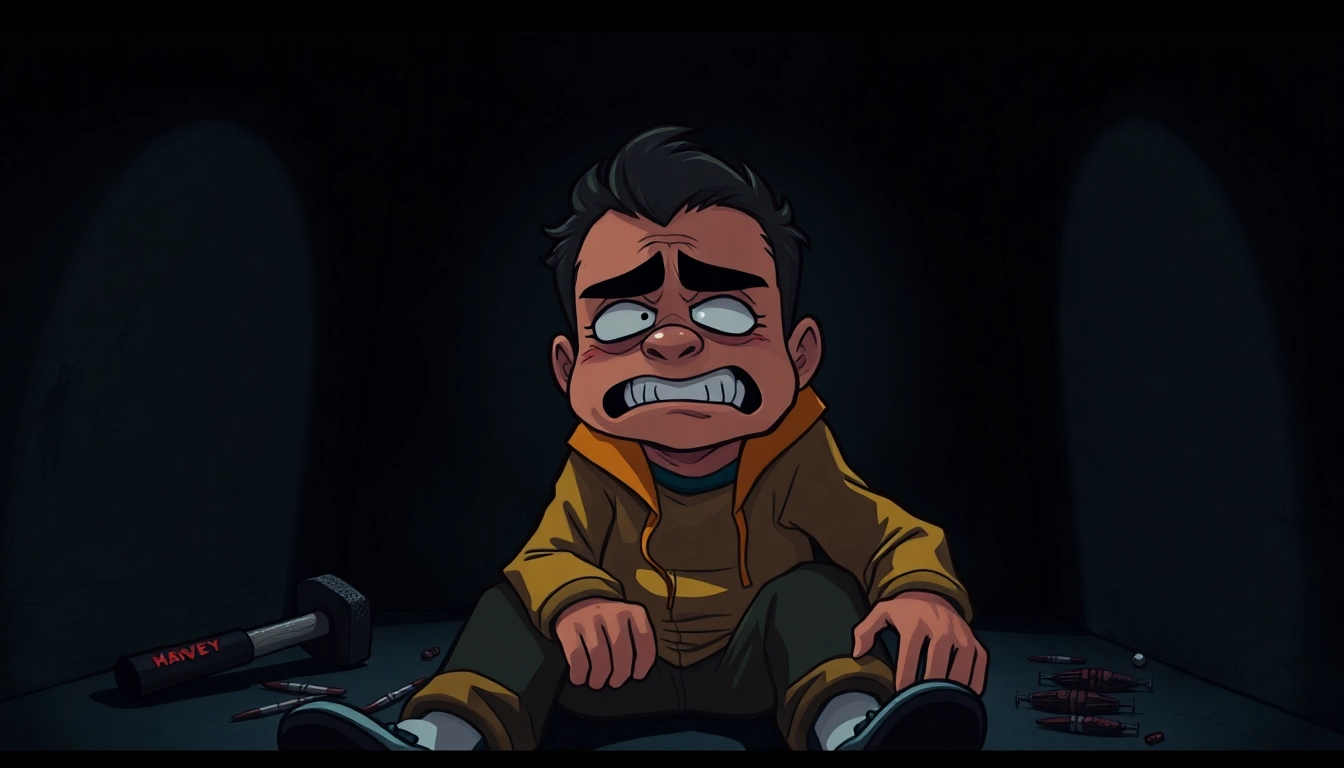Overview and Context: BloodMoney — A Dark Psychological Clicker Experience
Welcome to a disturbing psychological journey that challenges the very core of human morality. BloodMoney is not your typical clicker game; it is a deeply unsettling exploration of desperation, ethical boundaries, and the human psyche. Designed with a dark narrative and immersive mechanics, BloodMoney plunges players into a moral minefield where every click has consequences—both visible and psychological. The game’s core premise revolves around a person diagnosed with a life-threatening condition who must raise $25,000 for urgent medical treatment. Faced with limited options, they encounter Harvey, a cheerful yet mysterious character who offers an unconventional way to earn money—simply by clicking on him. This seemingly harmless act, however, spirals into a harrowing ordeal, forcing players to confront uncomfortable questions about morality, suffering, and survival.
The Mechanics of BloodMoney: How the Game Works
Clicking Mechanics and Profit Generation
At its core, BloodMoney employs a simple yet profoundly impactful clicking mechanic. The player is prompted to click on Harvey, who appears as an innocently smiling character offering a monetary reward for each interaction. Initially, each click seems benign, even humorous, with Harvey’s cheerful demeanor contrasting sharply with the dark undertones of the game. Every click earns a dollar, pushing players closer to their goal of $25,000. However, this profit comes at a cost: each click inflicts pain and suffering on Harvey, a detail subtly conveyed through visual cues and dialogue. The more you click, the more Harvey’s appearance changes—his smile fading, his eyes narrowing, and his physical state deteriorating. This mechanic creates a visceral sense of moral tension, as players see Harvey’s suffering escalate alongside their earnings.
Upgrade System and Increasing Darkness
As players progress, they unlock a shop offering various upgrades to maximize profit. These tools range from simple needles to brutal hammers and other unsettling weapons. Each upgrade boosts earnings but amplifies Harvey’s pain and suffering, creating a twisted risk-reward dynamic. The game’s upgrade system is designed to evoke a visceral response—players must decide whether to purchase more violent tools for faster gains or to preserve Harvey’s well-being. Interestingly, subtle details suggest Harvey may not fully comprehend what’s happening. For instance, Harvey is surprised by the violent nature of some tools, expecting harmless items like pillows for “pillow fights.” This revelation adds a layer of moral ambiguity, hinting that Harvey’s innocence might be genuine or manipulated, further complicating the ethical landscape.
The Dark Narrative: Exploring Harvey’s Character and Community Insights
Harvey: Innocence and Unawareness
Harvey’s cheerful persona initially positions him as a victim—an innocent being unwittingly caught in a cruel game. His surprise at violent tools suggests he might be unaware of their true nature, raising questions about his role in the moral dynamic. Is Harvey merely a puppet, or does he symbolize innocence trying to help, despite being exploited? As the game progresses, Harvey’s reactions and visual cues change, reflecting his increasing suffering. These subtle shifts deepen the emotional impact, making players question whether their actions are justified or morally reprehensible.
Community Insights and Player Reactions
The BloodMoney community is vibrant and diverse, with players sharing their experiences and moral reflections. Many note how the game’s visual and emotional cues effectively evoke guilt and empathy, even as they push for maximum profit. Discussions often revolve around whether it’s possible to achieve the “good” ending by minimizing Harvey’s suffering or if the game’s design inherently tempts players towards cruelty. Some players have observed that Harvey appears genuinely surprised by the violent tools, implying he might not understand what he’s involved in—a detail that intensifies the moral complexity. Community members also analyze gameplay videos, highlighting how subtle choices influence the three possible endings: the Good Ending, the Normal Ending, and the Bad Ending. Each ending offers a different perspective on morality, mercy, and human nature.
Gameplay Elements That Heighten Psychological Horror
Clicking Mechanics and Time Pressure
BloodMoney incorporates an intense sense of urgency, with players racing against the clock to reach the $25,000 goal. The ticking timer and escalating visual deterioration heighten the psychological tension, making every click feel weighty. The game’s pacing forces players to confront their own impulses—are they clicking mindlessly for profit, or carefully considering Harvey’s suffering? The time pressure amplifies the horror, as the player’s moral choices become more consequential with each passing second.
Upgrade System and Violence
The upgrade system is designed to evoke visceral reactions. Early upgrades are innocuous, but as players unlock tools like needles, scissors, and hammers, the violence becomes more explicit. Each violent upgrade significantly increases earnings, tempting players to push boundaries. The game’s visual cues—Harvey’s increasingly distressed expressions, physical deformities, and eventual exhaustion—serve as constant reminders of the moral cost. This escalation creates a haunting atmosphere, forcing players to reflect on the nature of their choices and the cost of survival.
Multiple Pathways and Endings
BloodMoney offers multiple pathways, each leading to different conclusions based on your choices. The game tracks how much harm you inflict and which upgrades you purchase, influencing the final outcome. The three core endings are:
- The Good Ending: Achieved by minimizing Harvey’s suffering, choosing less violent tools, and maintaining a sense of mercy.
- The Normal Ending: A balanced approach, utilizing moderate violence without fully sacrificing morality.
- The Bad Ending: Maximize profit at all costs, employing the most violent tools and disregarding Harvey’s suffering entirely.
Each ending reveals a different facet of human morality, from compassion to cold efficiency, making every playthrough a reflection on personal values and ethics.
Psychological Horror and Visual Cues
Building an Unsettling Atmosphere
BloodMoney masterfully employs visual and emotional cues to build a disturbing atmosphere. Harvey’s facial expressions, body language, and dialogue evolve in response to the player’s actions. Subtle shifts—such as Harvey’s eyes filling with fear or his posture slumping—serve as visual indicators of his deteriorating state. The game’s art style intensifies this feeling, with grotesque transformations becoming more pronounced as the game progresses. These cues evoke empathy and guilt, compelling players to confront their own moral boundaries.
Dialogue and Player Interaction
The game uses dialogue as a tool to deepen the psychological impact. Harvey’s cheerful tone gradually shifts to fear and despair, mirroring the player’s increasing moral compromise. The dialogue hints at Harvey’s innocence and confusion, especially when he reacts to the violent tools with surprise. This narrative layer adds emotional weight, making the player question whether their actions are justified or cruel.
Multiple Endings: Choices That Define Humanity
The Moral Spectrum in BloodMoney
The three endings serve as a moral spectrum, illustrating how different choices shape the outcome. The Good Ending emphasizes mercy and minimal harm, reflecting a compassionate approach. The Normal Ending balances profit with some moral compromise, while the Bad Ending showcases ruthless efficiency, regardless of Harvey’s suffering. Achieving these endings requires strategic choices—what tools to purchase, how many clicks to make, and whether to prioritize Harvey’s comfort or profit maximization.
Strategies for Unlocking Each Ending
Players have discovered that specific upgrade combinations influence their path. For example, avoiding the most violent tools like hammers and instead opting for scissors or needles can lead to the Normal Ending. Interestingly, some players report that even with violent tools like hammers, it’s possible to achieve the Good Ending by consciously minimizing Harvey’s suffering—indicating that the game subtly tracks moral choices beyond mere tool selection. These nuanced mechanics encourage replayability and introspection, as players explore different ethical approaches.
Community Insights and Player Reflections
Player Experiences and Moral Reflection
Community forums and gameplay videos reveal a wide range of reactions. Many players express discomfort and guilt, especially when witnessing Harvey’s physical and emotional decline. Yet, others are intrigued by the game’s challenge to their morals, debating whether profit justifies cruelty under extreme circumstances. The game’s subtle tracking of choices fosters discussion about human nature—are we inherently good, or do circumstances reveal our true selves?
Notable Discoveries and Hidden Details
Players have uncovered subtle clues suggesting Harvey’s genuine surprise at violent tools, which adds complexity to the moral debate. Some believe Harvey might be unaware of the full extent of his suffering, making players question whether they are morally culpable or if Harvey is an innocent pawn. These insights deepen the emotional engagement, making every click a moral act.
The Deeper Message: Humanity Under Pressure
The Duality of Good and Evil
BloodMoney acts as a mirror to human nature, exploring how desperation can push individuals towards cruelty or compassion. Harvey symbolizes innocence and hope, trying to help, while the shop and tools represent darker forces—perhaps an internal struggle within all of us. The game’s design suggests that morality is fluid, heavily influenced by circumstances and survival instinct.
Testing Humanity’s Boundaries
Ultimately, BloodMoney poses a fundamental question: How far are you willing to go when your life hangs in the balance? Will you choose mercy, or will you maximize profit regardless of suffering? The game’s multiple endings serve as a reflection of the player’s moral stance, prompting introspection about what defines humanity—compassion or ruthlessness.
Conclusion: Is Survival Worth the Moral Cost?
BloodMoney’s haunting gameplay and layered narrative make it a profound exploration of morality under duress. It challenges players to reflect on their own values, pushing the boundaries of empathy and cruelty. The game’s subtle mechanics, emotional cues, and multiple endings create a compelling experience that lingers long after the screen goes dark. As you navigate the dark corridors of this psychological horror, consider this: every click for survival is a moral choice, and the true cost may be more than just money—it may define who we are.
To experience this unsettling journey, dive into the world of bloodmoney, where each decision unfolds a deeper story about human nature and the limits of morality. And remember—the game’s moral compass is ultimately shaped by you. How far are you willing to go when your life depends on it?
Discover the full depth of BloodMoney’s dark narrative and gameplay by exploring its multiple pathways, upgrades, and endings. Engage with a community that continues to analyze and debate the game’s moral implications. Whether you aim for mercy or efficiency, your choices will resonate in the haunting aftermath. Are you ready to confront your own moral boundaries?
For more insights, gameplay videos, and community discussions, stay connected and keep questioning what it truly means to survive—at any cost. And if you’re intrigued by Harvey’s story and the dark world of BloodMoney, remember: your actions define your fate in this unsettling psychological horror experience.

